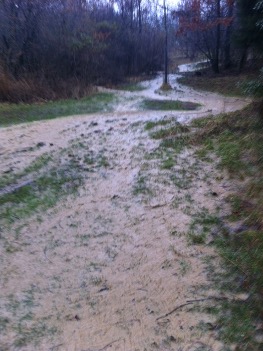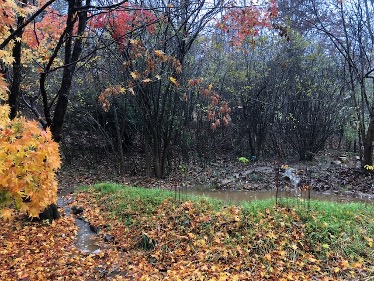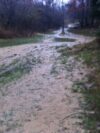
At Boxerwood we are always seeking to practice good stewardship of the land. One of the ways we do this by taking action to protect the streams and rivers that flow downstream. As we all know, we are part of the Chesapeake Bay watershed: all of the water that flows across Boxerwood enters Woods Creek, and on to the Maury River, the James River, and eventually to the Bay.
One of the three primary pollutants in the Chesapeake Bay is sediment - just good old dirt. For years we have been working to abate sediment runoff from Boxerwood, especially during heavy storms. The runoff starts at the parking lot, which is the highest point on the property. In 2015 I took this photo of a sediment-laden torrent rushing down from the parking lot after a 2-inch rain.
Since then, we have been working to slow the flow. Several years ago, we dug about 1000 feet of swales/berms; these berms run across the slopes and redirect the water, causing it to flow more slowly. This increases infiltration and decreases erosion. This year, thanks to a grant from the Virginia Department of Environmental Quality (with assistance from the Natural Bridge Soil & Water Conservation District), we expanded this effort by digging two new catchment basins -- one about halfway down the swale line, and the other at its terminus. We also expanded an existing catchment basin near the pollinator garden.These basins will capture sediment and further increase water infiltration.

Last week, I took this photo from a similar vantage point, also after a 2-inch rain. In the foreground is one of the freshly dug berms (green with a newly planted cover crop of winter rye and Austrian winter peas, to help stabilize it). With the help of the Rockbridge Area Master Gardeners, we recently planted about two dozen new trees at this site and around the other catchment basins: species include bald cypress, pawpaw, American cranberry, and swamp white oak -- a variety of water and shade loving natives. We also planted dozens of new ferns and native grasses. These plants will help take up water, provide food for wildlife (and people), as well as providing shade and improved wildlife habitat.
We are already seeing success in preventing sediment runoff into the watershed, and in twenty years or so I look forward to this area also being a shady refuge of healthy native trees.
On your next visit to Boxerwood, you can look for signage that highlights the swales and catchment basins. In the spring we plan to hold a workshop on stormwater management and how to implement these strategies in your own home landscape.
